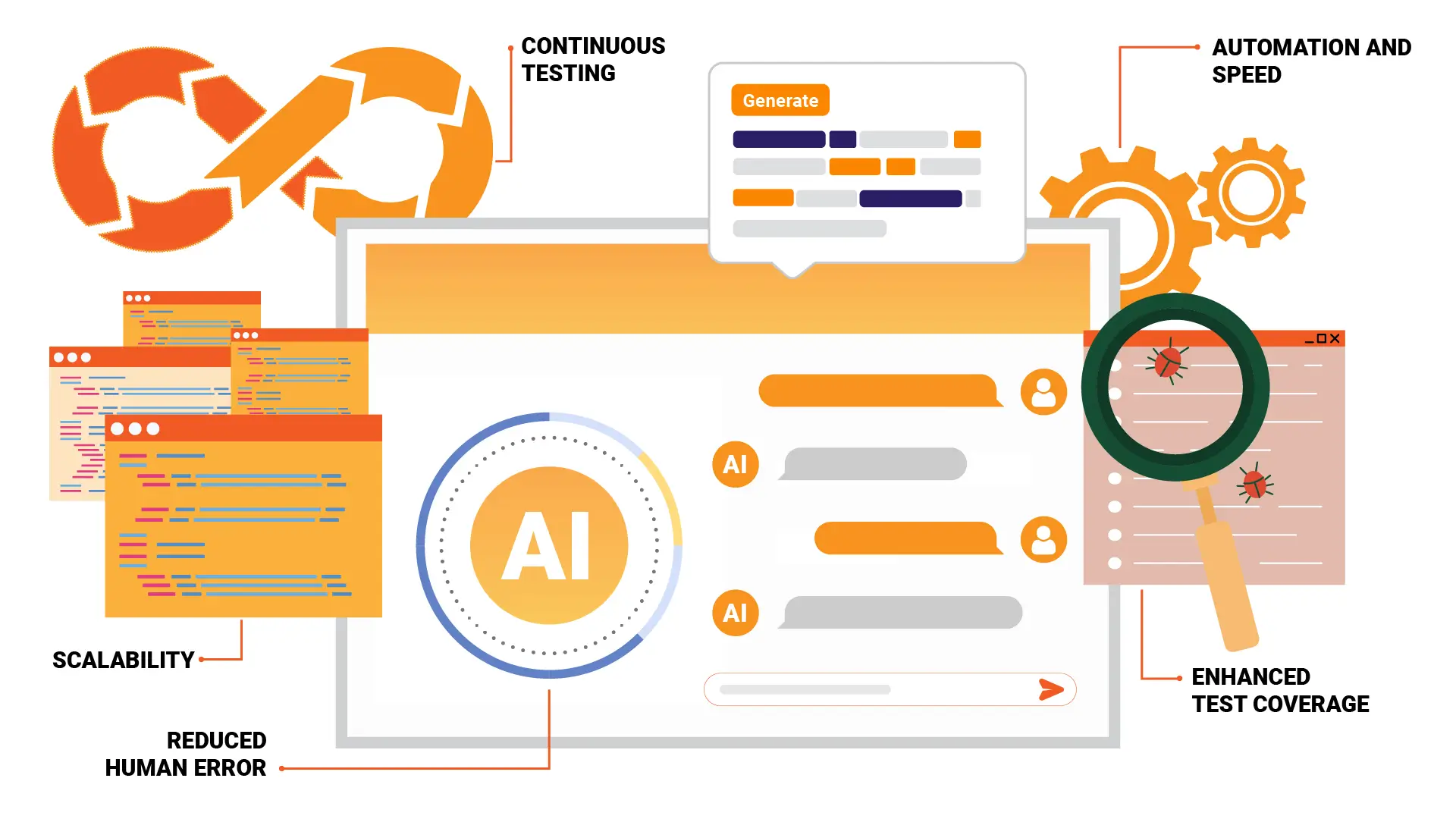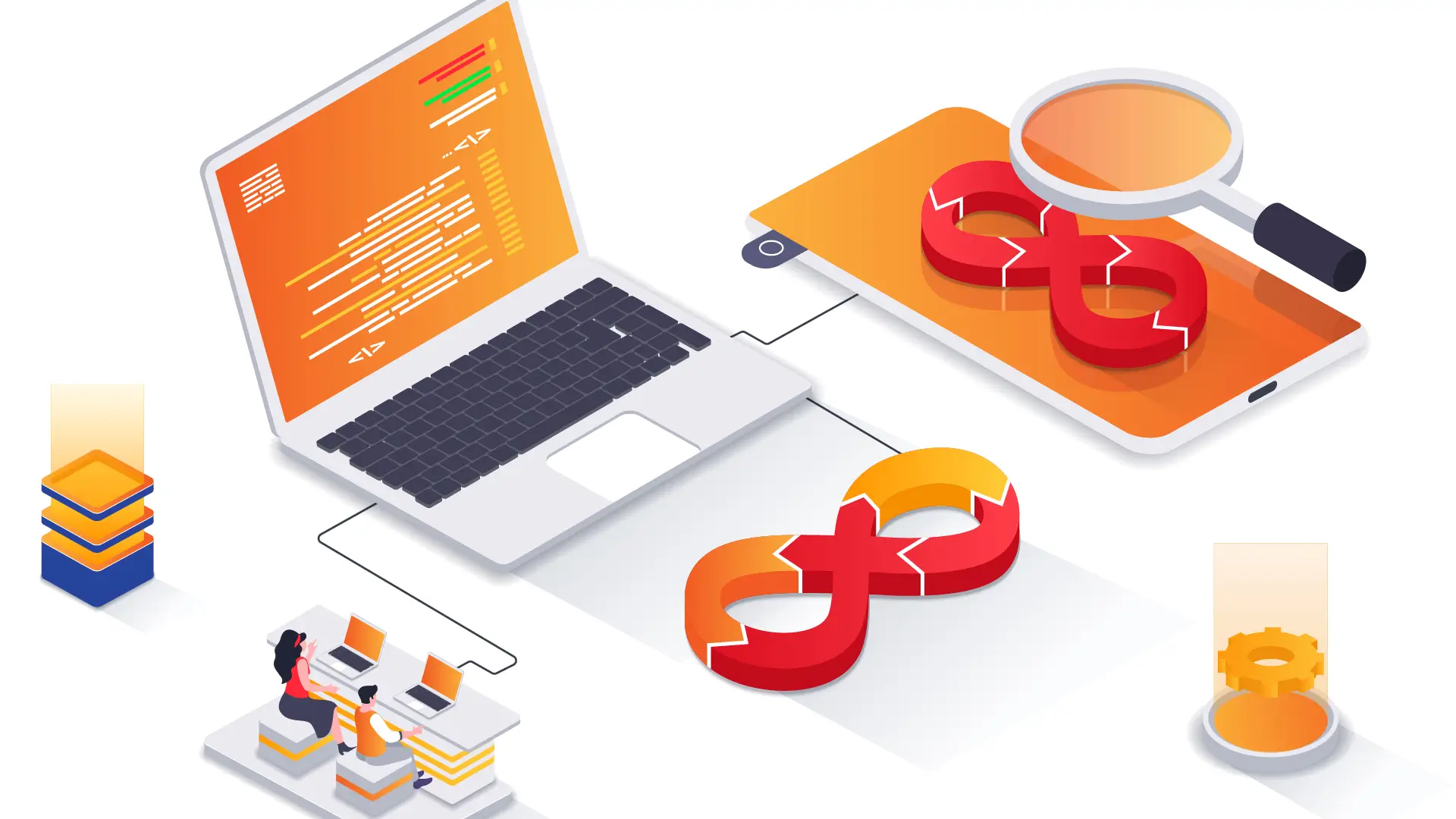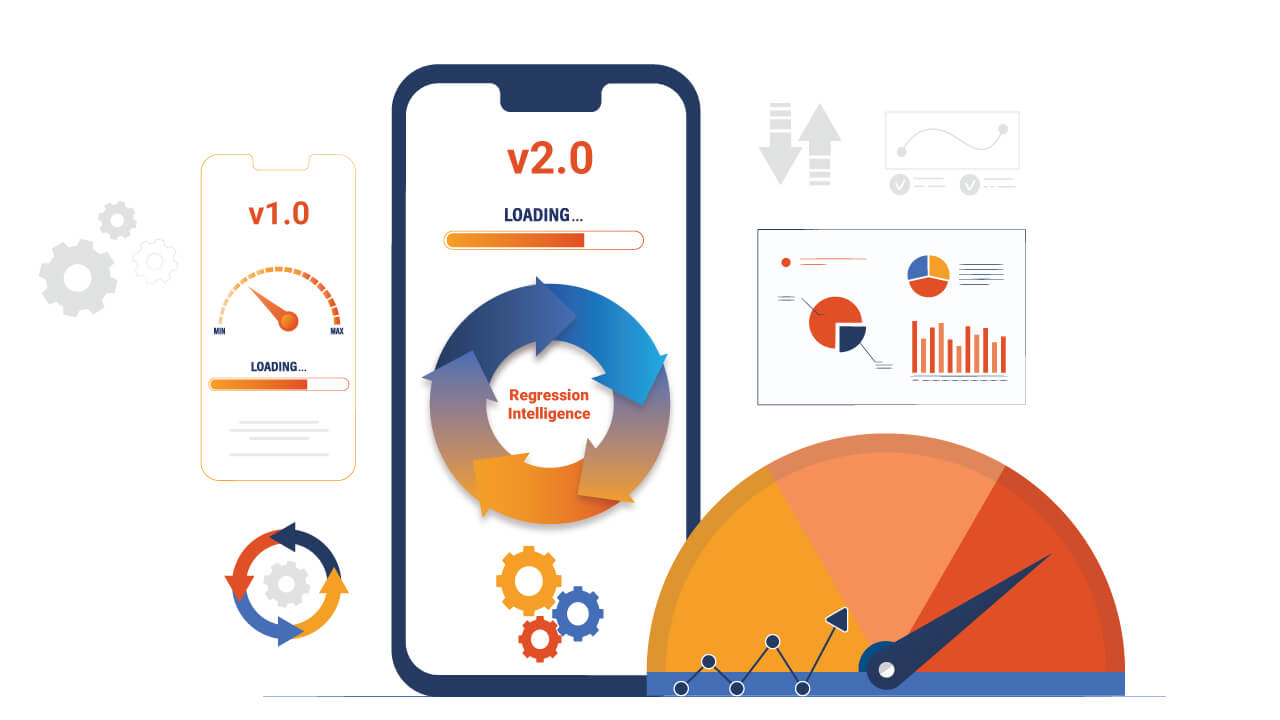Introduction
End-to-end testing, often referred to as E2E testing, constitutes a performance evaluation carried out within the mobile app development cycle. The product's functionalities are tested from one end to another to ensure the entire application flow functions without setbacks. A fundamental objective of E2E testing is to offer developers insights into the user experience by simulating real-world scenarios. This approach mimics actual user interactions, thoroughly validating all essential components within the test environment.
This comprehensive blog explores the fundamental concepts, significance, advantages, tools, and frameworks of E2E testing within the dynamic landscape of mobile app development.
Read: Everything About Mobile End-To-End Testing
What is End-to-End(E2E) Testing?
End-to-end testing is a comprehensive testing technique that validates the interactions between different components of an application, including databases, servers, APIs, and the user interface. End to end testing aims to ensure that the entire system functions seamlessly and meets the desired requirements. It goes beyond individual unit testing and integration testing, as it assesses the application's behavior as a whole.
End-to-end browser testing is vital in identifying potential issues arising when different components interact. This includes scenarios like data inconsistencies, communication failures, or performance bottlenecks that can affect the overall user experience. By thoroughly examining the application's flow from start to finish, testers can gain valuable insights into the system's reliability and performance under various conditions.
Importance of End-to-End Testing
End-to-end testing is crucial because it provides a holistic view of the application's performance and functionality. It helps detect system dependencies and maintains data integrity throughout the application. This testing method helps identify issues that might not be visible in unit or integration tests. By simulating real user scenarios, end-to-end testing ensures that the application will perform as intended in the real world, enhancing user satisfaction and reducing the risk of production failures.
End-to-End Automation Testing
Incorporating end-to-end automation testing is vital for improving the effectiveness of the testing process. Automated end-to-end testing allows for the execution of repetitive test cases without manual intervention, reducing the time and resources required for testing. By integrating end-to-end automation testing, teams can ensure consistent test execution, minimize human errors, and accelerate the feedback loop for developers, which is essential for agile and DevOps practices.
Difference Between Functional Testing and End-to-End Testing
Functional testing involves testing specific features or functions of the software, focusing on validating the software against the defined specifications. On the other hand, end-to-end testing evaluates the system's overall functionality and performance in an environment that mimics real-world usage.
Difference Between Integration Testing and End-to-End Testing
While integration testing evaluates the connectivity and data exchange between different modules or services within an application, end-to-end testing assesses the entire application's flow in a production-like environment.
Also read: 7 Differences Between Integration Testing and End to End Testing
Best Practices for End-to-End Testing
- Define Clear Objectives: Establish your goals with end-to-end testing, ensuring your chosen scenarios represent real-world use.
- Use Appropriate Tools: Select testing tools that best fit your application's technology stack and testing requirements.
- Create a Test Plan: Outline all the steps, from test case creation to execution and result analysis.
- Automate When Possible: Automate repetitive and time-consuming tests to increase efficiency and accuracy.
- Test in Realistic Environments: Ensure the testing environment resembles the production environment.
- Monitor and Analyze Results: Regularly review test results for insights and potential improvements in the testing process.
- Collaborate and Communicate: Encourage collaboration between developers, testers, and stakeholders to ensure that end-to-end testing aligns with user expectations and business goals.
By integrating these practices, you can enhance the effectiveness of your end-to-end testing, ensuring that your application is robust, reliable, and ready for production.
Check out: Guide to Accelerate and Strengthen Your End-to-End Testing Approach
How to Perform End-to-End Testing
End-to-end (E2E) testing is a key quality assurance activity that ensures a software application behaves as expected from start to finish. The goal is to mimic real-world scenarios and user interactions to detect system dependencies and ensure that all integrated pieces work together perfectly. Below is a detailed guide on how to carry out end-to-end testing effectively.
Step 1: Define the Testing Scope and Objectives
Before diving into testing, it clearly defines what needs to be tested and why it is crucial. This involves understanding the application's workflow, the critical business processes that the application supports, and the user interactions that need to be tested. It's also essential to define the success criteria for the testing phase, which will help assess whether the test cases have passed or failed.
Step 2: Plan the Test Cases
Once you have a clear scope, the next step is to plan the test cases. These should cover all the functionalities and user interactions with the application. When designing test cases, consider the following:
- User Scenarios: Identify the most common user behaviors and scenarios that need to be tested.
- Data Requirements: Determine the data needed for testing. This includes input data and expected outcomes.
- Integration Points: Pay special attention to the interfaces and integration points where different system components interact.
Also Check: How To Make Your End-To-End Tests Last Longer and Run Smoother
Step 3: Set Up the Test Environment
A proper test environment is crucial for E2E testing. This environment should replicate the production environment as closely as possible to uncover any environment-specific issues. Ensure all necessary hardware, software, networks, and other system components are in place and functioning.
Step 4: Execute Test Cases
With your test cases and environment ready, begin executing the test cases. This step involves:
- Running the Tests: Perform the tests according to the planned scenarios.
- Monitoring: Continuously monitor the system's behavior and outputs.
- Documenting: Keep detailed records of the test results, including any failures and anomalies.
Step 5: Analyze Test Results and Report
After testing, analyze the outcomes. Compare the actual results with expected outcomes to identify discrepancies. Any failures should be documented and reported to the development team for fixes. Successful tests should also be documented for future reference.
Step 6: Perform Regression Testing
Once issues are resolved, run regression tests to ensure the changes have not affected existing functionalities. This helps to maintain the stability and reliability of the software.
Step 7: Continuous Improvement
End-to-end testing is not a one-off activity but a continuous improvement process. Learn from each testing cycle. Refine your test cases, update testing methods, and improve the overall testing strategy to enhance software quality over time.
Read: The Importance of System Testing and End-to-End Testing
End-to-End Testing Lifecycle
1. Requirement Analysis:
End-to-end testing begins with a thorough analysis of the application's requirements. During this phase, testers collaborate with stakeholders to understand the end-to-end functionality and workflows of the application. This step is crucial for identifying the key areas covered during testing and ensuring that all scenarios are well-documented and agreed upon.
2. Test Planning:
Once the requirements are clear, the next step is to plan the testing process. This includes defining the scope, selecting the testing tools and environment, and scheduling the testing activities. Effective test planning also involves preparing the test data and configuring the necessary infrastructure, which is critical for mimicking real-world usage scenarios.
3. Test Case Development:
With the plan in place, testers develop detailed test cases covering all the application's functional and non-functional aspects. These test cases should be comprehensive enough to simulate real user behaviors and workflows, ensuring that each application component is tested in conjunction with others to detect any discrepancies.
4. Environment Setup:
Before actual testing can begin, a suitable environment that replicates the production setting needs to be set up. This environment setup includes configuring the hardware, software, network, and other testing tools. It's essential that this environment is as close to the live environment as possible to yield accurate results.
5. Test Execution:
Testers execute the test cases, often using automated testing tools to ensure consistency and efficiency. This phase is critical, revealing defects, bugs, and unexpected application behavior in a controlled setting. Any issues found are logged and communicated to the development team for fixes.
6. Reporting and Feedback:
Upon completion of the test execution, detailed reports summarize the findings. These reports are crucial in providing feedback to the development team and stakeholders. They include information on the bugs found, test coverage, and other relevant data to help improve the application.
7. Retesting and Regression Testing:
After the development team addresses the issues, the application undergoes retesting to ensure the fixes work as expected without introducing new bugs. Regression testing is also performed to confirm that new changes have not adversely affected existing functionalities.
8. Final Validation and Closure:
The final phase involves validating that the application meets all the specified requirements and performs optimally in all tested scenarios. Once validation is successful, the testing cycle can be closed, and the application moves closer to deployment.
Also read: AI's Role in Enhancing Software Quality Through Regression Testing
End-to-End Testing Success Metrics
To effectively measure the success of end-to-end testing, several key metrics should be considered:
1. Test Coverage:
This metric assesses how much the testing has covered all defined scenarios and requirements. High test coverage indicates a thorough examination of the application's functionalities.
2. Defect Density:
Defect density measures defects found per unit of the application's functionality or code. This metric helps understand the application areas that may require more focused testing or improvement.
3. Mean Time to Detect (MTTD):
MTTD is the average time to detect a defect during the testing phase. A lower MTTD is preferable as it suggests that the testing process effectively identifies issues.
4. Mean Time to Repair (MTTR):
MTTR is the average time required to fix a defect once it has been identified. Efficient processes and skilled development teams typically have a shorter MTTR, leading to faster release cycles.
5. Test Automation Percentage:
This is the percentage of tests automated versus those conducted manually. A higher automation percentage usually leads to more efficient testing phases, as automated tests can be run frequently and consistently without additional cost or time.
6. Pass/Fail Rate:
This straightforward metric tracks the number of tests that pass versus those that fail. A high pass rate indicates good application health, while a high fail rate may suggest systemic issues.
Check: A Comprehensive Guide on Automated Testing
How End-to-End Testing Improves App Performance

End-to-end browser testing directly impacts app performance by uncovering critical defects and vulnerabilities that could compromise the user experience. Through rigorous testing of the entire application workflow, end to end testing helps identify and rectify issues that might not be apparent during isolated testing phases.
One of the key benefits of end-to-end browser testing is its ability to detect integration problems. Compatibility issues may arise when different components are combined to create the final application, leading to unexpected errors or failures. By proactively addressing these integration challenges, end-to-end testing ensures smoother interactions between components, reducing the likelihood of potential breakdowns.
Moreover, end-to-end browser testing helps optimize app performance by identifying and addressing application architecture bottlenecks. Performance testing during end-to-end testing evaluates how the app responds under various loads and usage patterns. This information empowers developers to fine-tune the application's performance, resulting in faster response times, reduced resource consumption, and a better user experience.
Advantages of End to End Test Automation
End-to-end test automation offers several advantages, making it an essential approach in modern software development and QA processes. End to end test automation provides faster feedback, increases test coverage, and enables continuous testing, all of which enhance app performance and reduce time-to-market.
End-to-end test automation allows for the execution of complex test scenarios more efficiently and consistently than manual testing. Automated tests can be run 24/7, providing continuous feedback on the application's performance and stability. This ongoing testing helps identify issues promptly, allowing development teams to address them before they escalate into major problems.
Furthermore, end-to-end test automation reduces human errors, ensuring accurate and reliable test results. As a result, developers can focus on building new features and improvements rather than repeatedly conducting time-consuming manual tests. Additionally, automated tests can be easily integrated into the Continuous Integration/Continuous Deployment (CI/CD) pipeline, facilitating a streamlined development process.
Also read: Exploring the top CI/CD tools for DevOps
End-to-end test automation is a crucial component of software testing that ensures the seamless functioning of an application throughout its user journey. End to end testing plays a pivotal role in delivering a high-quality user experience by pinpointing potential issues and optimizing app performance. Embracing test automation in the end-to-end testing process adds further value by increasing efficiency, accuracy, and scalability. As technology continues to evolve, integrating end-to-end testing and automation will remain essential for businesses seeking to maintain a competitive edge in the dynamic world of software development.
Measuring End-to-End Testing Effectiveness
Measuring the effectiveness of End-to-End (E2E) Testing is critical to ensure software applications meet their intended functionality and user requirements. Here are key metrics and approaches to consider:
- Test Coverage: Measure how much your E2E tests cover the software functionalities. High test coverage comprehensively evaluates the application’s features and workflows.
- Defect Density: Monitor the defects found relative to the software size. This metric helps assess the overall quality and reliability of the application.
- Pass/Fail Rate: Track the passed-to-failed test cases ratio. A high pass rate generally indicates good software health, while a high fail rate may point to underlying issues in the application.
- Time to Resolution: Measure the time taken to resolve identified defects. Faster resolution times typically reflect a more efficient and responsive development process.
- Test Execution Time: Monitor the time taken to execute E2E tests. Optimizing test execution time without compromising quality is essential for efficient development cycles.
- User Story Completion Rate: Evaluate how many user stories are successfully tested and completed through E2E testing. This ensures that the software aligns with the requirements.
- Automated vs Manual Testing Metrics: For automated E2E tests, track the maintenance time, flakiness (inconsistent results), and execution time. For manual tests, consider the time and resources required.
- Feedback from Stakeholders: Incorporate feedback from users and stakeholders as a qualitative measure of the software’s performance and usability.
Remember, the goal of measuring E2E testing is to identify defects and ensure the software delivers a seamless and functional experience to the end-user. Regularly reviewing and adjusting your measurement strategies can significantly enhance the effectiveness of your E2E testing process.
Examples of End-to-End Testing
End-to-end (E2E) testing is critical in verifying complex systems' overall functionality. Here are some real-world examples:
- E-Commerce Website: This involves testing the entire shopping process, from product selection and shopping cart management to payment processing and order confirmation. E2E testing ensures that all these interconnected components work seamlessly to provide a smooth shopping experience.
- Banking Applications: Testing scenarios include account creation, money transfers, statement generation, and customer support interaction. This ensures that the application functions reliably under various transactional scenarios.
- Healthcare Systems: Involves testing patient registration, appointment scheduling, medical record access, and prescription management functionalities. Given the sensitive nature of healthcare data, the focus is on data accuracy and security.
- Travel Booking Platforms: Tests cover searching for flights/hotels, booking, payment, confirmation, and cancellation processes. The goal is to ensure users can plan their travel without system errors.
- Gmail Functionality: Involves testing the complete workflow of using a Gmail account, including login, email management (reading, composing, sending), and logging out. This example demonstrates how E2E testing checks each step a user might take when interacting with an email service.
These examples illustrate how E2E testing is applied across different industries, ensuring software performs as intended in real-world scenarios.
Check out: The Power of Test Automation
Challenges in End-to-End Testing
End-to-end testing is critical in software development, ensuring that applications perform as expected in real-world scenarios. However, this comprehensive testing approach comes with its own set of challenges:
- Effective Team Communication and Collaboration: End-to-end testing often requires heightened levels of communication and collaboration compared to manual testing. This encompasses discussions about test automation objectives, scope, and selection of tools with various stakeholders, including developers, business analysts, and project managers.
- Selecting the Right Testing Tool: Choosing the right one is crucial with many testing tools available. It's vital to conduct research and consider the application's specific requirements under test, as a mismatch in tool selection can lead to test automation failure.
- Demand for Skilled Resources: Contrary to the belief that manual testers can easily transition to automated testing, end-to-end testing demands specific technical skills for designing and maintaining the test framework. The need for skilled resources with programming capabilities and a deep understanding of test automation tools is critical.
- Choosing an Appropriate Testing Approach: Determining the correct testing approach is fundamental. This involves decisions about reducing effort in test script implementation and maintenance, ensuring the longevity of test suites, and generating useful test reports.
- High Initial Investment Cost: The initial end-to-end testing phase involves significant costs, including framework design, tool selection, and possible licensing fees. Despite the long-term benefits, the upfront investment can be a barrier.
Understanding and addressing these challenges early in the testing process can lead to more effective and efficient end-to-end testing strategies, ultimately contributing to the success of software projects.
What are the Types of End-to-End Testing Methods?

Depending on the end goal of the developers, there are two kinds of testing methods:
● Horizontal E2E Testing
This testing method tests the application across various platforms, interfaces, or applications that work in conjunction with each other. It aims to ensure the seamless interaction and functionality of the application across different components. This type of testing is often conducted within the scope of a single Enterprise Resource Planning (ERP) system or a similar complex application.
Key Points:
- Cross-Platform Validation: Horizontal E2E testing ensures that the application functions correctly across different platforms, such as different operating systems, browsers, and devices.
- User-Centric Perspective: This approach is user-centric, simulating real-world scenarios where users interact with the application across various touchpoints. It aims to validate whether users can navigate through different parts of the app without encountering critical errors.
- Integration Testing: Horizontal E2E testing often involves integration testing, where the integration points between various modules, components, or systems are thoroughly validated.
- End-to-End Flow: Test scenarios cover end-to-end flows that span multiple components, applications, or systems. For example, it may involve testing the entire order-to-payment process in an e-commerce application.
- Usability and Compatibility: It checks the usability and compatibility of the application by considering how users experience the application in different environments.
● Vertical E2E Testing
Vertical end to end testing, on the other hand, is conducted sequentially and hierarchically, focusing on testing the application's various layers or components from top to bottom. This type of testing ensures that each layer or component interacts correctly with the layers above and below it.
Key Points:
- Layered Validation: Vertical E2E testing is organized hierarchically, focusing on validating the functionality and integration of each layer independently and in relation to the entire system.
- Layer Interaction: It ensures that data and processes flow seamlessly between different layers, including the data layer, presentation layer, and business logic layer.
- Complex Applications: Vertical E2E testing is particularly suitable for complex applications with multiple interconnected components, where isolating and validating each layer's behavior is crucial.
- Moving Parts: This method is effective for applications with intricate internal workings and a high degree of interaction between different modules.
- Non-UI Systems: While horizontal testing often involves user interfaces, vertical E2E testing applies to non-UI systems, like backend services, APIs, or microservices.
Benefits of Conducting E2E Testing & Performance Test Mobile App
You can take advantage of various benefits if you apply E2E testing. Apart from the basic benefit of providing a comprehensive, end to end test, here are the main benefits of conducting E2E testing.
- Reduces the Risk of Future Bugs: Properly conducted this E2E tests also drastically reduce the risk of future bugs. The application is subjected to intensive testing after every iteration – thus ensuring very few bugs in the future.
- Cost-Effectiveness & Time-Effectiveness: Properly conducting this testing can also increase the cost associated with the project. This testing can save you and your enterprise time and money by reducing repetition.
- Expands the Coverage of the Test: This testing also expands the coverage of the test by considering all of the sub-systems associated with the application. It's a very enumerative form of testing that looks after the quality of every application's dimension.
- Increases the Level of Efficiency: All of the professionals involved in the development process prefer E2E testing. Developers don't have to worry too much about the testing process, and the testers can thoroughly test the product. Project managers benefit greatly from the valuable insight they receive.
Check out: Top 5 Data-Driven Reasons to Use Audio Visual AI for End-to-End Testing
Comprehensive Insight into End-to-End Test Frameworks
End-to-end (E2E) test frameworks are the essential components in the software development lifecycle to ensure an application's robustness, functionality, and quality. These frameworks facilitate testing an application's workflow, from start to finish, by simulating real-world user interactions and scenarios.
Key Components of E2E Test Frameworks:
- Browser and Platform Support: E2E test frameworks should support a variety of browsers and platforms, ensuring cross-browser and cross-device compatibility testing.
- Test Infrastructure: E2E test frameworks provide the necessary infrastructure to create and manage test cases, automate test execution, and generate reports.
- Test Orchestration: These frameworks enable the sequencing of test cases, ensuring that the application is tested in the correct order to simulate user interactions accurately.
- Data Management: E2E tests may require different data sets for various scenarios. Frameworks should provide ways to manage and inject test data into the tests.
- Page Object Model (POM): POM is a design pattern used to represent a web page's different components and interactions. E2E test frameworks often implement POM to create a more maintainable and readable test codebase.
- Assertions and Matchers: These frameworks include assertion libraries to validate that the application behaves as expected. Matchers allow testers to write expressive and human-readable assertions.
Benefits of E2E Test Frameworks:
- Comprehensive Testing: E2E tests cover the entire application workflow, identifying issues that might not be caught by unit or integration tests.
- Real-World Scenarios: E2E tests simulate user interactions, providing insights into how the application behaves under real-world conditions.
- Early Bug Detection: Detecting and fixing issues at the end of development or production can be costly. E2E tests help catch bugs early in the development process.
- Regression Testing: E2E tests play a crucial role in ensuring that any new code modifications do not disrupt the functionality of existing features.
- Confidence in Releases: Successful E2E tests provide confidence in the stability and reliability of software releases.
Read: A Complete Guide to Regression Testing
A Few E2E Testing Tools for Seamless Software Quality
testRigor
testRigor is an end to end testing tool that allows you to view complex test executions and is an entirely cloud-hosted system. It lets you create seamless test automation for manual and hybrid QA testers since it is no code. It allows them to focus on testing new features and edge cases instead of focusing on repetitive tasks.
testRigor also supports cross-platform and cross-browser testing for web and mobile, API functionality, phone calls, and SMS. The tool can also record and playback and autonomously create test cases.
Mabl
Mabl is an end-to-end testing tool that lets you execute and create test scripts from a single platform. Mabl fetches data from the user's actions allowing users to complete software testing using scriptless code.
Mabl provides end-to-end testing using integrated UI and API tests through a single platform. The tool validates status code responses, body, and header values allowing you to execute automated API testing. It integrates with apps like Bamboo and Azure Pipelines and notification systems like Microsoft Teams and Slack.
Autify
Autify lets you manage, create, and execute complex test cases and have thorough reports on completed tests - this web and mobile app automation tool provides visual regression testing coverage. This end to end testing tool identifies the differences in your app and runs tests without requiring maintenance. You can use the tool's Chrome extension to record interactions.
It supports cross-browser testing and lets you test on real devices, allowing you to provide a seamless user experience. It integrates with Jenkins, Slack, and TestRail.
How HeadSpin's Advanced Testing Solutions Empower Businesses to Optimize End to End Mobile App Test Automation
HeadSpin revolutionizes the landscape of end-to-end mobile app test automation by offering a comprehensive suite of tools and services that streamline the testing process and elevate the quality of web, mobile, video, and audio experiences across the entire application lifecycle.
● Advanced Testing with the HeadSpin Platform
At its core, the HeadSpin Platform simplifies the intricacies of end to end testing. It empowers development teams to ensure impeccable quality in every facet of their applications. From initial development to post-launch optimization, HeadSpin's comprehensive approach covers the entire app development and usage journey.
● Data-Driven Insights with AI-Powered Analysis
HeadSpin's end-to-end testing tool isn't just about conducting tests and generating invaluable insights. Through its data-rich approach and AI-powered analytics, the tool provides high-quality, actionable insights that empower you to optimize and perfect your digital experiences. From identifying performance bottlenecks to pinpointing usability issues, HeadSpin's analytics drive data-driven decision-making, enabling you to refine your application precisely.
● Global Device Cloud for Seamless App Test Automation
HeadSpin's distinctive strength lies in its extensive global device infrastructure, housing thousands of SIM-enabled devices worldwide. This expansive device network enables seamless app test automation, allowing you to test your application's compatibility, performance, and functionality on various real devices. This global reach ensures that your app is validated under a wide range of network conditions, locales, and user scenarios, ensuring it performs optimally in every corner of the globe.
● Versatile Deployment with the HeadSpin Appliance
The HeadSpin Appliance introduces a novel dimension to testing infrastructure. Featuring a portable, secure, and temperature-controlled environment, the appliance is an ideal setting for conducting tests on various compatible applications. Whether deployed in the cloud, on-premises, or anywhere else, the appliance offers a standardized and controlled testing environment that ensures consistent and reliable results.
Summing Up
To sum it up, E2E testing is a valuable form of testing that will allow your business to benefit from a comprehensive and highly developed app. When you conduct tests on your app, make sure to use E2E testing so that maximum coverage is ensured. It'll also save you a lot of time and money.
With AI-powered insights, HeadSpin empowers you to fine-tune your app's performance, functionality, and user experience while streamlining your testing process.
Harness the capabilities of HeadSpin to optimize your testing strategy and deliver an app that exceeds expectations.
FAQs
Q1. What is end to end testing in Agile?
Ans: End-to-end testing is software testing that tests flow from beginning to end instead of only testing individual steps. It's possible to test an application and its connection with other applications as the user experiences it by performing end to end tests.
Q2. What is the difference between end to end testing and system testing?
Ans: System testing validates the system as per specifications. It tests software functionality, and you run it manually and through automation.
End to End testing tests the software flow from end to end. It requires knowledge of the interconnected system, and you run it manually.



























-1280X720-Final-2.jpg)










